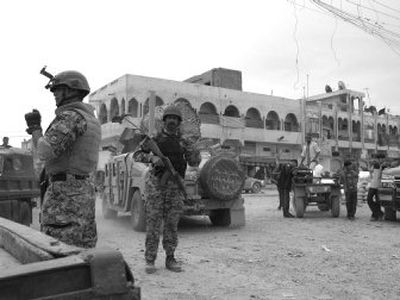U.S., al-Sadr in uneasy truce

BAGHDAD, Iraq – U.S. troops are conducting security sweeps in the Shiite stronghold of Sadr City for the first time in three years, part of a revamped plan to pacify the capital. Yet the Mahdi Army militia of Shiite cleric Muqtada al-Sadr has not risen up to fight them, despite U.S. raids on their homes and growing Sunni attacks on Shiites.
“Until now, our leader has ordered us to keep quiet,” explained Ayad al-Khaby, a local official in al-Sadr’s organization. “This is in order for the security plan to succeed.”
After four years of hostility, al-Sadr and the Americans are cooperating uneasily as the United States and Iraq attempt to tame Baghdad’s sectarian violence. American officials, who in recent months described his Mahdi Army and other Shiite militias as the biggest threat to Iraq’s stability, now praise the Shiite cleric.
The collaboration represents a remarkable shift for two adversaries who control the largest armies in Iraq and who fought some of the fiercest battles since the 2003 U.S.-led invasion.
For al-Sadr, it is the latest stage in an evolution from populist cleric to guerrilla fighter to political kingmaker and now to powerbroker. In the early months of the occupation, U.S. officials dismissed al-Sadr as irrelevant to Iraq’s future. Today, they view him as a political catalyst who can help keep Iraq together – or implode it.
“We’re very encouraged by what we’re seeing on the ground right now in Sadr City,” said Maj. Gen. William Caldwell, the U.S. military’s chief spokesman in Baghdad. “There is a tremendous amount of cooperation and dialogue ongoing. It’s proven to be very beneficial to both sides.”
It is a tenuous cooperation that could collapse at any moment. U.S. troops walk a thin line between peace and war in Sadr City. Each day tests the tolerance of al-Sadr and his fighters, who are widely believed to operate death squads. U.S. commanders concede that their troops may face isolated attacks.
“They are an occupation force. We refuse their presence totally,” said Mohammad Abu Haider, a Mahdi Army commander who has battled Americans. “Their ultimate goal is to destroy the Sadr trend.”
On Thursday, gunmen ambushed the convoy of Sadr City’s mayor, Rahim al-Darraji, seriously wounding him and killing two of his bodyguards. Darraji, an al-Sadr appointee, has been negotiating with U.S. and Iraqi government officials over the role of U.S. troops in the security clampdown.
A few hours earlier, at a luncheon with Western journalists, Maj. Gen. Joseph Fil, the U.S. commander in charge of Baghdad, spoke about Darraji.
“We’re in Sadr City, working closely with the mayor and it’s been completely permissive. It’s a collaboration,” he said.
Publicly, al-Sadr has criticized the U.S. presence inside his stronghold. He is a fierce nationalist who has long demanded a withdrawal of U.S. troops from Iraq, and his authority derives in large part from his opposition to the occupation. But privately, he has ordered his militiamen to lay low no matter how much they are provoked by American forces, said fighters and al-Sadr representatives in interviews.
The absence of full-blown resistance against U.S. troops and the recent decline in the number of bodies found with signs of torture, usually attributed to the Mahdi Army, suggest that al-Sadr still controls the bulk of his forces, even as U.S. intelligence officials assert his grip over the Mahdi Army is slipping. Such murders have dropped by a third during the first month of the security plan, said Fil.
“If the Sayyid says it is in the best interest to rise up against the Americans, we will rise. If the Sayyid say there’s no interest, we won’t rise,” said Haider, using the honorific for a descendant of the Prophet Muhammad.
After the invasion, al-Sadr channeled the growing disenchantment against the occupation, attracting poor, young and dispossessed Shiites into his militia. In 2004, al-Sadr’s forces staged two major uprisings against U.S. forces. Since then, the Mahdi Army has repeatedly attackedU.S. troops and Iraqi security forces.
Today, al-Sadr’s loyalists control 30 seats in the Iraqi parliament and four ministries. His support enabled Iraqi Prime Minister Nouri al-Maliki, a conservative Shiite, to enter office.
Despite intense U.S. pressure, al-Maliki refused to take stern actions against his benefactor. He publicly rebuked American raids into Sadr City. In October, he ordered U.S. forces to lift a blockade of the area.
As a key component of the new security plan, al-Maliki proposed to U.S. officials that he would persuade al-Sadr to order his militiamen to stand down, according to two al-Maliki aides. In return, he asked U.S. forces to focus their efforts on combating Sunni insurgents, which the Shiite-led government views as the roots of the sectarian violence. U.S. commanders have publicly said they do not favor one sect over the other.
Despite the recent positive signs, U.S. generals remain skeptical.
“We have to be very cautious and expect there may be some setbacks,” Fil said, acknowledging that the Mahdi Army may be waiting for an opportunity to attack. U.S. military officials are keeping a close eye on al-Sadr’s whereabouts. They say he is in neighboring Iran, but his followers insist he is in Iraq.